BOOK OF HOURS, use of Rome, in Latin, ILLUMINATED MANUSCRIPT ON VELLUM
BOOK OF HOURS, use of Rome, in Latin, ILLUMINATED MANUSCRIPT ON VELLUM [Rouen, c.1500] 170 x 125mm. 110 leaves: 1 6 , 2 8 , 3 2 , 4-8 8 , 9 2 , 10-15 8 , 16 4 , COMPLETE, with signature marks a-q i-iiii in inner lower corner of rectos of first half of each gathering, 22 lines in brown ink in a lettre batârde between two verticals and 23 horizontals ruled in pink, justification: 104 x 68mm, text capitals touched yellow, one-line versals of liquid gold on grounds of red or blue with gold decoration, line-endings of the same colours, two-line initials with pink-tinged foliate monochrome staves on gold grounds, PANEL BORDERS ON EVERY PAGE with flowers or acanthus on liquid gold grounds that extend to fillet-frame the text, one small and FOURTEEN LARGE MINIATURES WITHIN ARCHITECTURAL FRAMES OF CAMAïEU D'OR (slight spotting to a few margins, a few small losses of surface pigment). 19th-century red velvet with two silver fore-edge catches, gilt edges (splitting at joints, ink stain and lacking hinged clasps). Brown cloth case. PROVENANCE: The illumination is the work of an artist who was active in Rouen, although the Calendar and liturgical use of the Offices of the Virgin and of the Dead are general Roman use. Added prayers on the front flyleaf are written in a 16th-century French hand. Sir Weetman Dickinson Pearson Bart, first Viscount Cowdray (1856-1927): armorial bookplate inside lower cover. The Cowdray sale was Sotheby's, 16-17 February, 1948. H.W. and K.E. Leatham of Yorkshire: armorial bookplate with the date 1917 inside front cover. CONTENTS: Calendar ff.1-6v; Gospel sequences and Passion according to John ff.7-16v; Office of the Virgin, use of Rome, with interspersed Hours of the Cross and of the Holy Spirit from lauds ff.17-58v: matins f.17, lauds f.27v, prime f.36, terce f.39, sext f.41v, none f.44, vespers f.46v, compline f.51; Seven Penitential Psalms and Litany ff.59-70v; Office of the Dead, use of Rome ff.71-94; prayers to the Trinity, the Holy Face, the Virgin -- Obsecro te , O Intemerata , Stabat mater dolorosa -- and to Saints Michael, John the Baptist, John the Evangelist, Peter and Paul, James, the Apostles, Stephen, Lawrence, Christopher, Sebastian, to several martyrs, to Saints Nicholas, Anthony, Romanus, Anne, Mary Magdalene, Catherine, Margaret, Barbara, Apollonia, All Saints, for peace, for the dead ff.94v-110. ILLUMINATION: This is a very handsome and polished example of the work of Robert Boyvin From a family with an established position in the Rouen booktrade since early in the fifteenth century, Boyvin's career can be traced from 1487 until 1536. His success and standing is shown by the fact that he was one of the artists that Georges d'Amboise, Cardinal Archbishop of Rouen turned to when he sought to expand his library. It is on the basis of the manuscript of Seneca's Epîtres (Paris, BnF, lat.8551) made for the Cardinal in 1503 that Boyvin's style can be identified: F. Lehoux, 'Sur un manuscrit de l'école de Rouen décoré par Jean Serpin et Robert Boyvin pour le cardinal Georges d'Amboise', Mélange dédiés à la mémoire de Félix Grat , 1949, II, pp.323-328. Subsequently, more than fifty manuscripts, mostly Books of Hours, have been identified as from his hand: I. Delauney, 'Le manuscrit enluminé à Rouen au temps du cardinal Georges d'Amboise: l'oeuvre de Robet Boyvin et de Jean Serpin', Annales de Normandie , 3 (1995), pp.211-244. Boyvin's is a distinctive style, his characters almost always have rather long and triangular noses, the men with narrow chins and the women with porcelain complexions, drapery has angular contours and is painted with a restricted palette dominated by a single shade of blue, red, pink and grey. In his finest works, such as the present Hours, he shows particular skill and aesthetic sense in the use of gold to describe and give richness to drapery, architecture and armour. The text on every page of the manuscript is framed with a delicately executed border composed of a gol
BOOK OF HOURS, use of Rome, in Latin, ILLUMINATED MANUSCRIPT ON VELLUM
BOOK OF HOURS, use of Rome, in Latin, ILLUMINATED MANUSCRIPT ON VELLUM [Rouen, c.1500] 170 x 125mm. 110 leaves: 1 6 , 2 8 , 3 2 , 4-8 8 , 9 2 , 10-15 8 , 16 4 , COMPLETE, with signature marks a-q i-iiii in inner lower corner of rectos of first half of each gathering, 22 lines in brown ink in a lettre batârde between two verticals and 23 horizontals ruled in pink, justification: 104 x 68mm, text capitals touched yellow, one-line versals of liquid gold on grounds of red or blue with gold decoration, line-endings of the same colours, two-line initials with pink-tinged foliate monochrome staves on gold grounds, PANEL BORDERS ON EVERY PAGE with flowers or acanthus on liquid gold grounds that extend to fillet-frame the text, one small and FOURTEEN LARGE MINIATURES WITHIN ARCHITECTURAL FRAMES OF CAMAïEU D'OR (slight spotting to a few margins, a few small losses of surface pigment). 19th-century red velvet with two silver fore-edge catches, gilt edges (splitting at joints, ink stain and lacking hinged clasps). Brown cloth case. PROVENANCE: The illumination is the work of an artist who was active in Rouen, although the Calendar and liturgical use of the Offices of the Virgin and of the Dead are general Roman use. Added prayers on the front flyleaf are written in a 16th-century French hand. Sir Weetman Dickinson Pearson Bart, first Viscount Cowdray (1856-1927): armorial bookplate inside lower cover. The Cowdray sale was Sotheby's, 16-17 February, 1948. H.W. and K.E. Leatham of Yorkshire: armorial bookplate with the date 1917 inside front cover. CONTENTS: Calendar ff.1-6v; Gospel sequences and Passion according to John ff.7-16v; Office of the Virgin, use of Rome, with interspersed Hours of the Cross and of the Holy Spirit from lauds ff.17-58v: matins f.17, lauds f.27v, prime f.36, terce f.39, sext f.41v, none f.44, vespers f.46v, compline f.51; Seven Penitential Psalms and Litany ff.59-70v; Office of the Dead, use of Rome ff.71-94; prayers to the Trinity, the Holy Face, the Virgin -- Obsecro te , O Intemerata , Stabat mater dolorosa -- and to Saints Michael, John the Baptist, John the Evangelist, Peter and Paul, James, the Apostles, Stephen, Lawrence, Christopher, Sebastian, to several martyrs, to Saints Nicholas, Anthony, Romanus, Anne, Mary Magdalene, Catherine, Margaret, Barbara, Apollonia, All Saints, for peace, for the dead ff.94v-110. ILLUMINATION: This is a very handsome and polished example of the work of Robert Boyvin From a family with an established position in the Rouen booktrade since early in the fifteenth century, Boyvin's career can be traced from 1487 until 1536. His success and standing is shown by the fact that he was one of the artists that Georges d'Amboise, Cardinal Archbishop of Rouen turned to when he sought to expand his library. It is on the basis of the manuscript of Seneca's Epîtres (Paris, BnF, lat.8551) made for the Cardinal in 1503 that Boyvin's style can be identified: F. Lehoux, 'Sur un manuscrit de l'école de Rouen décoré par Jean Serpin et Robert Boyvin pour le cardinal Georges d'Amboise', Mélange dédiés à la mémoire de Félix Grat , 1949, II, pp.323-328. Subsequently, more than fifty manuscripts, mostly Books of Hours, have been identified as from his hand: I. Delauney, 'Le manuscrit enluminé à Rouen au temps du cardinal Georges d'Amboise: l'oeuvre de Robet Boyvin et de Jean Serpin', Annales de Normandie , 3 (1995), pp.211-244. Boyvin's is a distinctive style, his characters almost always have rather long and triangular noses, the men with narrow chins and the women with porcelain complexions, drapery has angular contours and is painted with a restricted palette dominated by a single shade of blue, red, pink and grey. In his finest works, such as the present Hours, he shows particular skill and aesthetic sense in the use of gold to describe and give richness to drapery, architecture and armour. The text on every page of the manuscript is framed with a delicately executed border composed of a gol
.jpg)
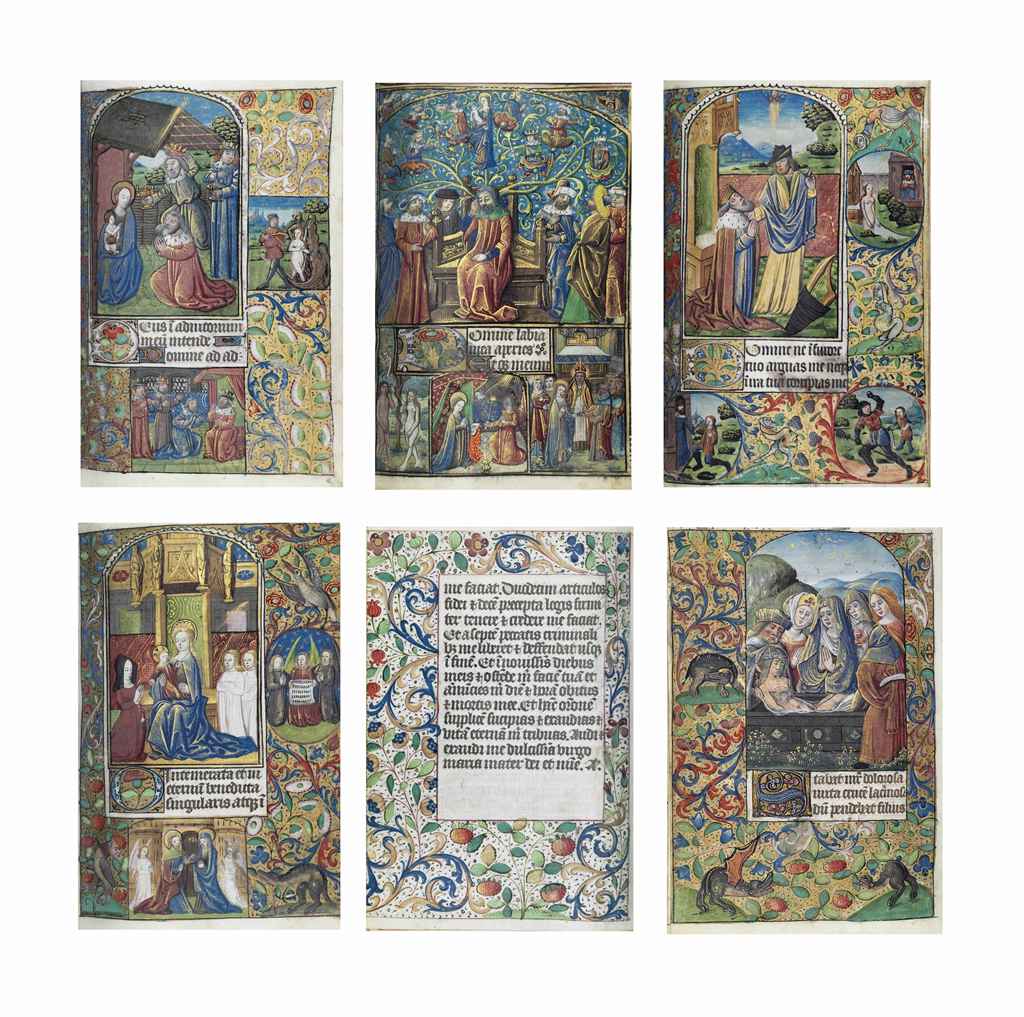
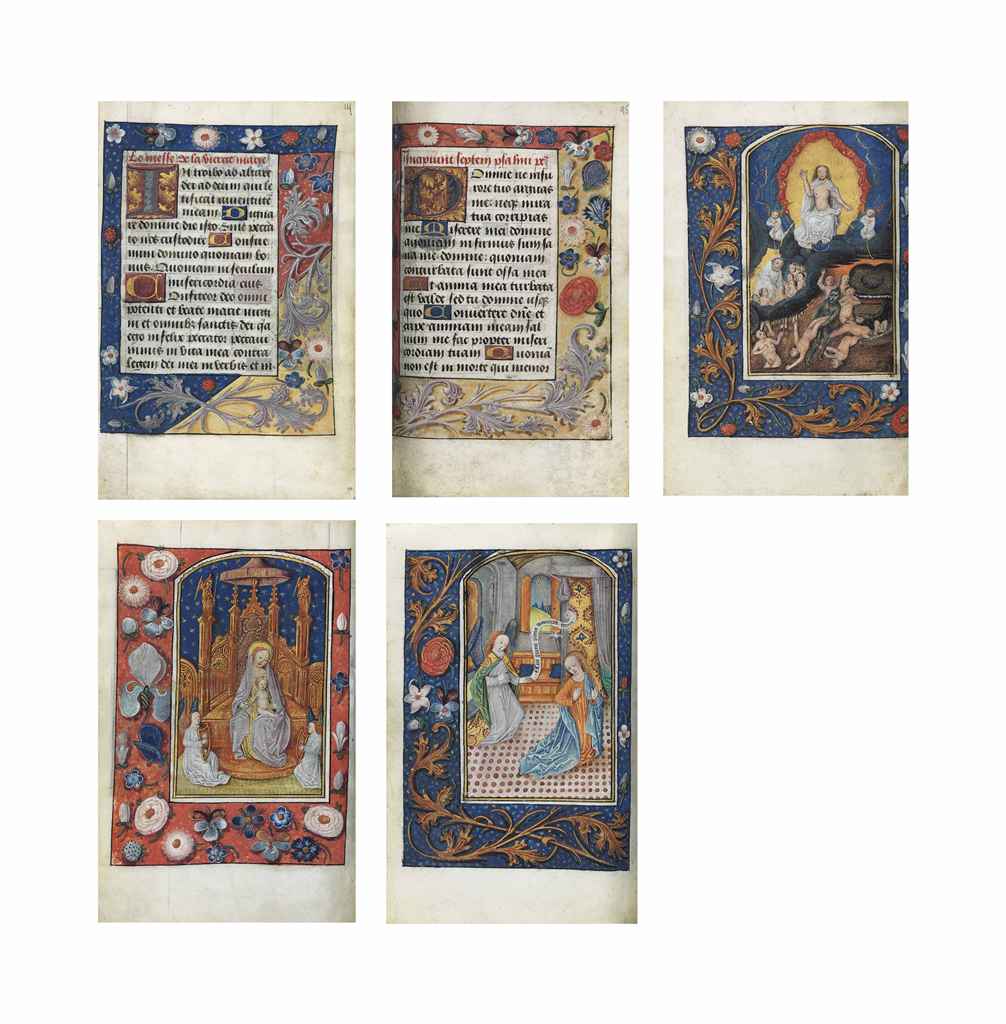
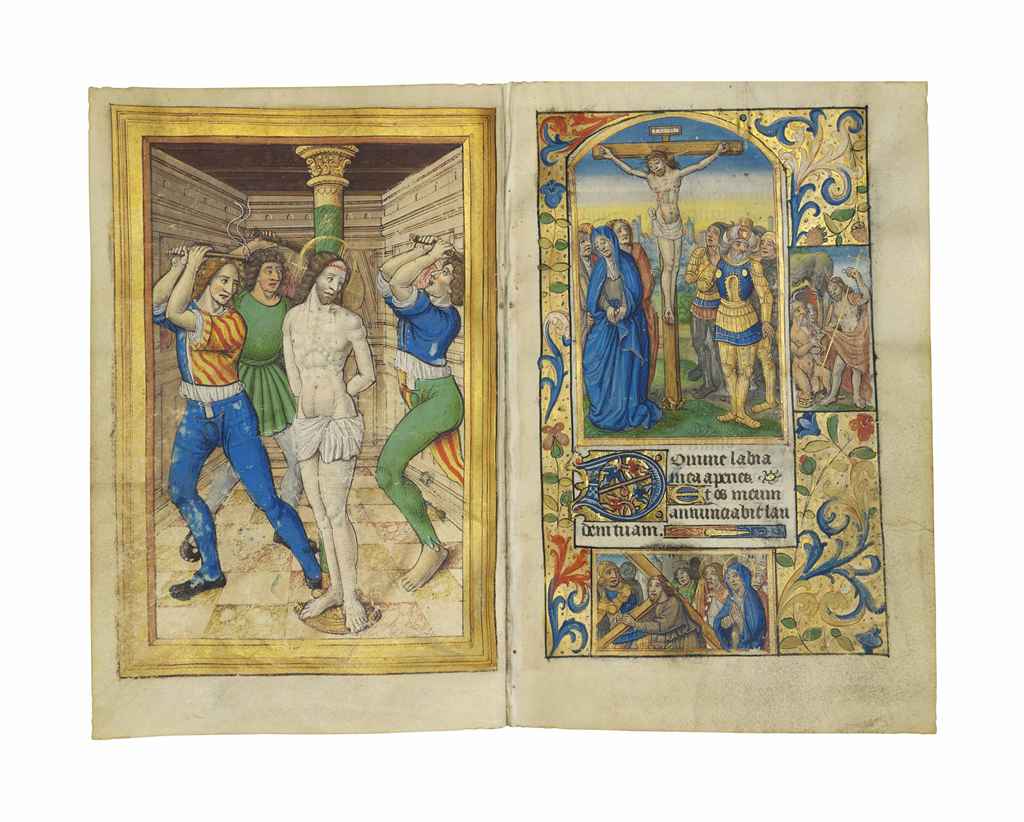
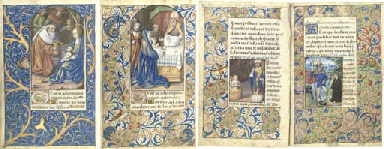
.jpg)
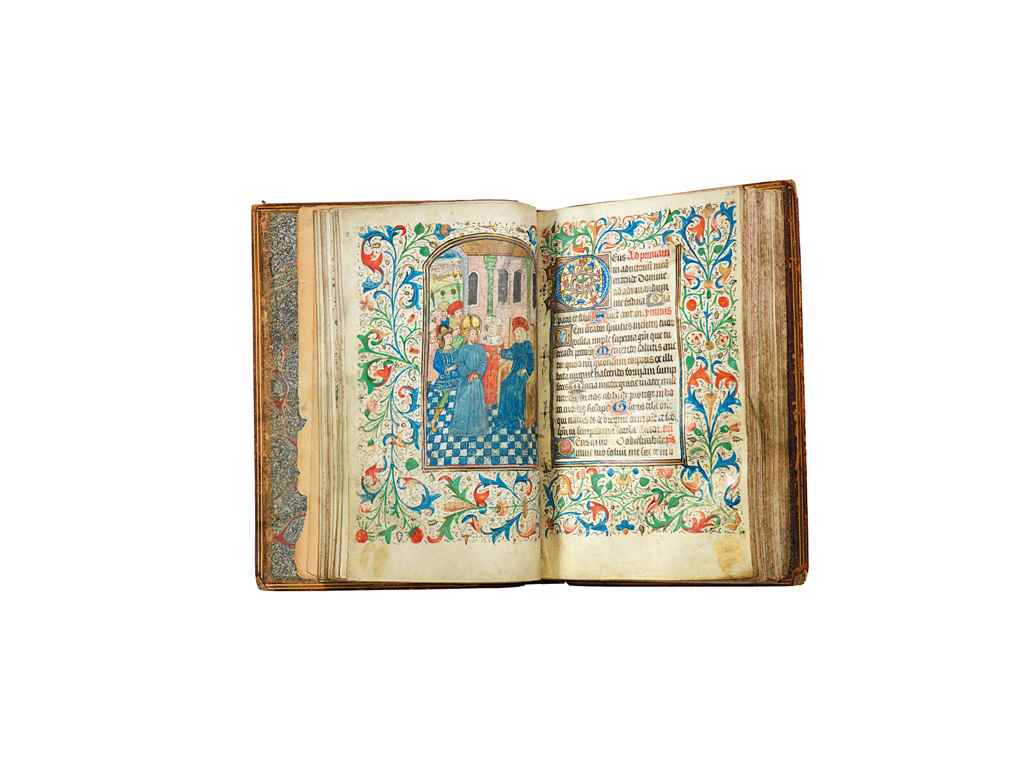


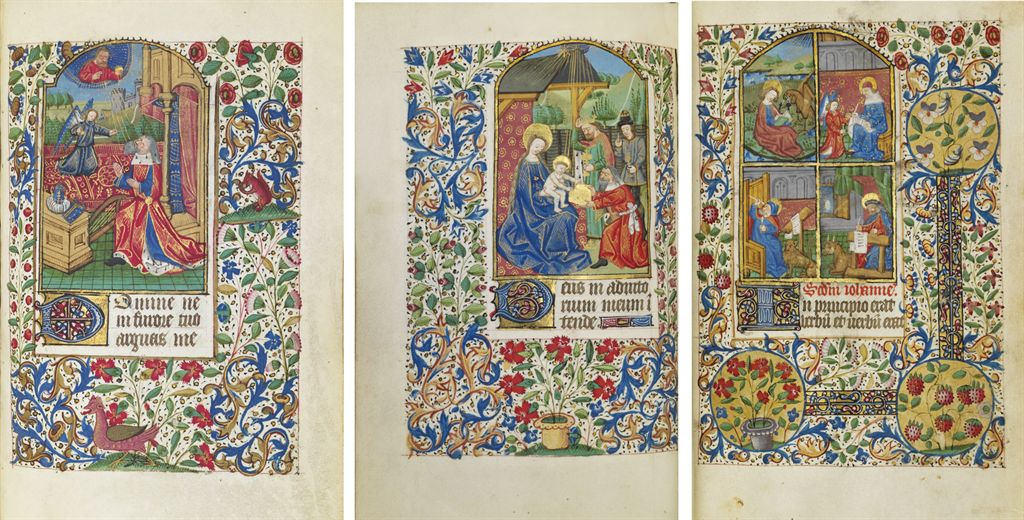
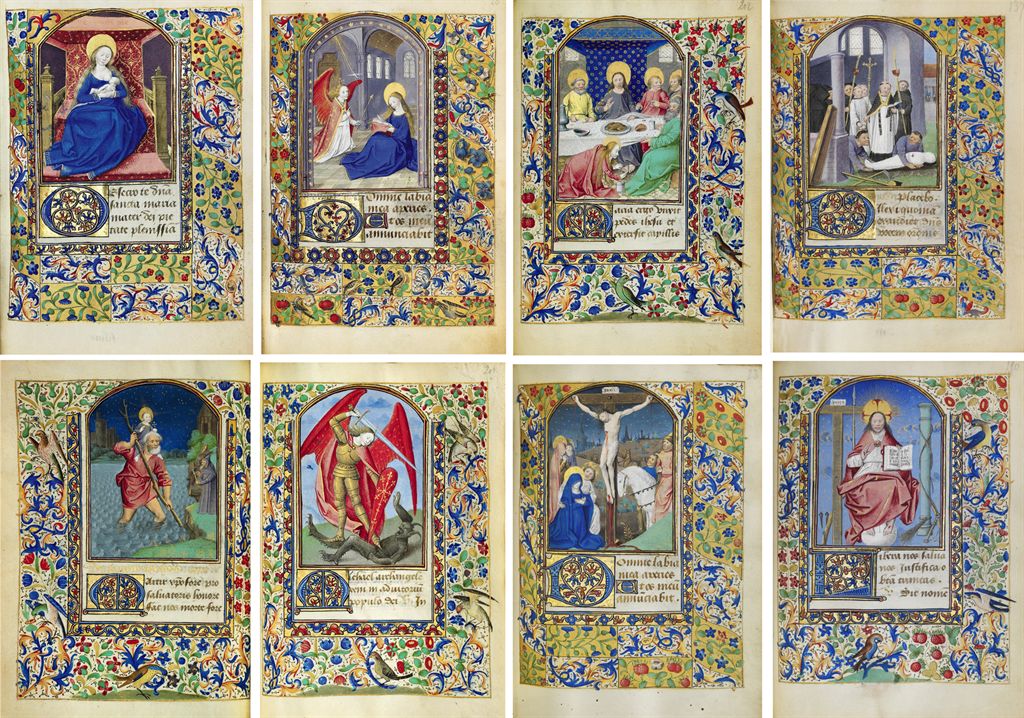
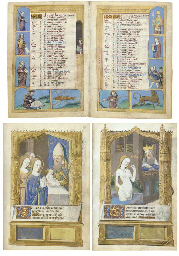
.jpg)


Try LotSearch and its premium features for 7 days - without any costs!
Be notified automatically about new items in upcoming auctions.
Create an alert